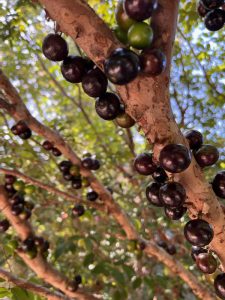This fruit tree is a superstar in Brazil.
In the plant world, there are some superstars. Sometimes it’s because of their beauty, like roses and orchids. Sometimes it’s due to their usefulness like corn and bamboo. Sometimes it’s because they have multiple assets. Jaboticaba, or Jabuticaba, Plinia cauliflora, or Myrciaria cauliflora is one such plant.
I have had this growing for over 10 years now, and it has recently begun to fruit profusely, sometimes twice per year. This small tree is native to Brazil, near rivers, so prefers a moist area with slightly acid, rich soil. However, when I planted mine, I wasn’t as smart as I am now. I planted it too close to my patio, which allows the cement to make the soil more alkaline. Because I routinely allow leaves to accumulate around the tree, it isn’t complaining about the pH, thankfully. BUT, learn from my mistake. Never plant any fruit tree that drops fruit close to an area where you don’t want purple stains!
Because this tree is so beautiful, I refuse to move it. When it’s fruiting, it forces me to get out there and pick them before they drop. The birds help, as this fruit also attracts many species to enjoy the feast. The fruit is very high in nutrients and antioxidants with a texture and taste similar to concord or muscadine grapes.

The word “cauliflora” indicates that its fruit is actually attached to the trunk of the tree, as you can clearly see in this photo.
Jaboticaba has gorgeous mottled, peeling bark, and small white flowers that are extremely fragrant. They are so fragrant, I wonder why no one has made a perfume out of them. When it is blooming, it fills the air with an intoxicating scent letting you know that fruit is coming soon.
Although a slow growing tree, if you have patience, it will reward you with beauty, fragrance and fruit. It is suitable to plant in a large container, as it rarely gets taller than 8- 10 feet even in the ground. Jaboticaba is often used as a bonsai specimen because it’s slow growing, and of small stature. Be sure to use good potting soil, mulch with fallen leaves or pine needles to increase the acidity, and keep it moist at all times. Placing a saucer under the pot will help with this and encourage quicker growth. Jaboticaba will grow in full sun to partial shade.
Jaboticaba rarely needs pruning. But if it does, or if you have other fruit trees that need pruning, please check out this article because fruit tree pruning is different than regular tree pruning.
Don’t be hesitant to plant trees that grow more slowly. Remember, those fast growing trees can be high maintenance. Time goes by quickly, and before you know it, your little tree that seemed to be so sluggish, could turn out to be a superstar in your landscape.
A tree this interesting, deserves superstar status.


Source: UF/IFAS Pest Alert




